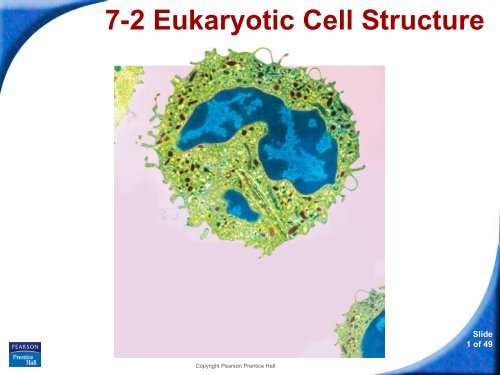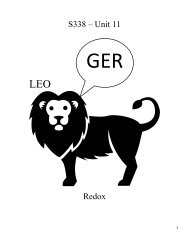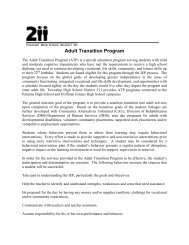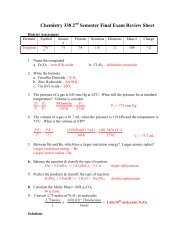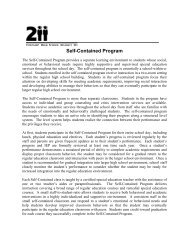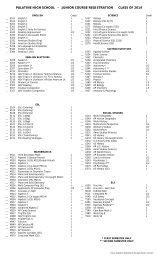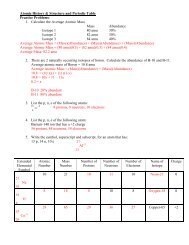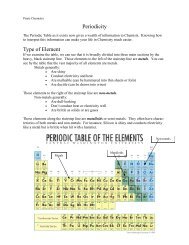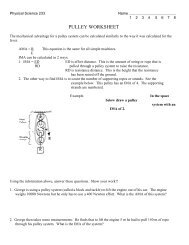7-2 Eukaryotic Cell Structure
7-2 Eukaryotic Cell Structure
7-2 Eukaryotic Cell Structure
You also want an ePaper? Increase the reach of your titles
YUMPU automatically turns print PDFs into web optimized ePapers that Google loves.
7-2 <strong>Eukaryotic</strong> <strong>Cell</strong> <strong>Structure</strong><br />
Slide<br />
1 of 49<br />
Copyright Pearson Prentice Hall
7-2 <strong>Eukaryotic</strong> <strong>Cell</strong> <strong>Structure</strong><br />
Comparing the <strong>Cell</strong> to a Factory<br />
<strong>Eukaryotic</strong> <strong>Cell</strong> <strong>Structure</strong>s<br />
<strong>Structure</strong>s within a eukaryotic cell that perform<br />
important cellular functions are known as<br />
organelles.<br />
<strong>Cell</strong> biologists divide the eukaryotic cell into two<br />
major parts: the nucleus and the cytoplasm.<br />
The cytoplasm is the portion of the cell outside<br />
the nucleus.<br />
Slide<br />
2 of 49<br />
Copyright Pearson Prentice Hall
7-2 <strong>Eukaryotic</strong> <strong>Cell</strong> <strong>Structure</strong><br />
Nucleus<br />
What is the function of the nucleus?<br />
• The nucleus is the control center of the cell.<br />
• The nucleus contains all the cell's DNA and<br />
coded instructions for making proteins and other<br />
important molecules.<br />
Slide<br />
3 of 49<br />
Copyright Pearson Prentice Hall
7-2 <strong>Eukaryotic</strong> <strong>Cell</strong> <strong>Structure</strong><br />
Nucleus<br />
The Nucleus<br />
Chromatin<br />
Nucleolus<br />
Nuclear envelope<br />
Nuclear<br />
pores<br />
Slide<br />
4 of 49<br />
Copyright Pearson Prentice Hall
7-2 <strong>Eukaryotic</strong> <strong>Cell</strong> <strong>Structure</strong><br />
Nucleus<br />
The nucleus is<br />
surrounded by a<br />
nuclear envelope<br />
composed of two<br />
membranes.<br />
The envelope is<br />
dotted with nuclear<br />
pores, which allow<br />
material to move in<br />
and out of the<br />
nucleus.<br />
Nuclear<br />
envelope<br />
Nuclear<br />
pores<br />
Slide<br />
5 of 49<br />
Copyright Pearson Prentice Hall
7-2 <strong>Eukaryotic</strong> <strong>Cell</strong> <strong>Structure</strong><br />
Nucleus<br />
The granular material in the nucleus is called<br />
chromatin.<br />
Chromatin consists of DNA bound to protein.<br />
Chromatin<br />
Slide<br />
6 of 49<br />
Copyright Pearson Prentice Hall
7-2 <strong>Eukaryotic</strong> <strong>Cell</strong> <strong>Structure</strong><br />
Nucleus<br />
When a cell divides, chromatin condenses to form<br />
chromosomes.<br />
Chromosomes contain the genetic information that is<br />
passed from one generation of cells to the next.<br />
Slide<br />
7 of 49<br />
Copyright Pearson Prentice Hall
7-2 <strong>Eukaryotic</strong> <strong>Cell</strong> <strong>Structure</strong><br />
Nucleus<br />
Most nuclei also contain a nucleolus.<br />
The nucleolus is where the assembly of<br />
ribosomes begins.<br />
Nucleolus<br />
Slide<br />
8 of 49<br />
Copyright Pearson Prentice Hall
7-2 <strong>Eukaryotic</strong> <strong>Cell</strong> <strong>Structure</strong><br />
Ribosomes<br />
What is the function of the ribosomes?<br />
• Proteins are assembled on ribosomes.<br />
• One of the most important jobs carried<br />
out in the cell is making proteins.<br />
Slide<br />
9 of 49<br />
Copyright Pearson Prentice Hall
7-2 <strong>Eukaryotic</strong> <strong>Cell</strong> <strong>Structure</strong><br />
Ribosomes<br />
Ribosomes produce proteins by following coded<br />
instructions that come from the nucleus.<br />
<strong>Cell</strong>s that are active in protein synthesis are often<br />
packed with ribosomes.<br />
Instructions<br />
from<br />
nucleus…<br />
Slide<br />
10 of 49<br />
Copyright Pearson Prentice Hall
7-2 <strong>Eukaryotic</strong> <strong>Cell</strong> <strong>Structure</strong><br />
Endoplasmic Reticulum<br />
What is the function of the endoplasmic<br />
reticulum?<br />
• The ER is where lipid (fat) components of<br />
the cell membrane are assembled, along<br />
with proteins.<br />
Slide<br />
11 of 49<br />
Copyright Pearson Prentice Hall
7-2 <strong>Eukaryotic</strong> <strong>Cell</strong> <strong>Structure</strong><br />
Endoplasmic Reticulum<br />
Endoplasmic<br />
Reticulum<br />
Ribosomes<br />
Slide<br />
12 of 49<br />
Copyright Pearson Prentice Hall
7-2 <strong>Eukaryotic</strong> <strong>Cell</strong> <strong>Structure</strong><br />
Endoplasmic Reticulum<br />
There are two types of ER—rough and smooth.<br />
The portion of the ER involved in protein synthesis is<br />
called rough endoplasmic reticulum, or rough ER.<br />
Ribosomes are found on the surface of rough ER.<br />
Slide<br />
13 of 49<br />
Copyright Pearson Prentice Hall
7-2 <strong>Eukaryotic</strong> <strong>Cell</strong> <strong>Structure</strong><br />
Endoplasmic Reticulum<br />
Smooth ER does not have ribosomes on its surface.<br />
Smooth ER contains collections of enzymes that<br />
perform specialized tasks, such as synthesis of<br />
membrane lipids and detoxification of drugs.<br />
Slide<br />
14 of 49<br />
Copyright Pearson Prentice Hall
7-2 <strong>Eukaryotic</strong> <strong>Cell</strong> <strong>Structure</strong><br />
Golgi Apparatus<br />
What is the function of the Golgi apparatus?<br />
• The Golgi apparatus sorts and packages<br />
proteins and other materials from the<br />
endoplasmic reticulum for storage in the cell or<br />
secretion outside the cell.<br />
• From the Golgi apparatus, proteins are then<br />
“shipped” to their final destinations throughout<br />
the cell or outside of the cell.<br />
Slide<br />
15 of 49<br />
Copyright Pearson Prentice Hall
7-2 <strong>Eukaryotic</strong> <strong>Cell</strong> <strong>Structure</strong><br />
Golgi Apparatus<br />
The Golgi apparatus appears as a stack of closely<br />
apposed membranes.<br />
Slide<br />
16 of 49<br />
Copyright Pearson Prentice Hall
7-2 <strong>Eukaryotic</strong> <strong>Cell</strong> <strong>Structure</strong><br />
Lysosomes<br />
What is the function of lysosomes?<br />
• Lysosomes are small organelles filled with<br />
enzymes.<br />
• Lysosomes break down lipids, carbohydrates,<br />
and proteins into small molecules that can be<br />
used by the rest of the cell.<br />
• Lysosomes also break down organelles that<br />
have outlived their usefulness.<br />
Slide<br />
17 of 49<br />
Copyright Pearson Prentice Hall
7-2 <strong>Eukaryotic</strong> <strong>Cell</strong> <strong>Structure</strong><br />
Vacuoles<br />
What is the function of vacuoles?<br />
• Saclike structures that store materials<br />
such as water, salts, proteins, and<br />
carbohydrates.<br />
Slide<br />
18 of 49<br />
Copyright Pearson Prentice Hall
7-2 <strong>Eukaryotic</strong> <strong>Cell</strong> <strong>Structure</strong><br />
Vacuoles<br />
In many plant cells there<br />
is a single, large central<br />
vacuole filled with liquid.<br />
The pressure of the<br />
central vacuole allows<br />
plants to support heavy<br />
structures such as leaves<br />
and flowers.<br />
Vacuole<br />
Slide<br />
19 of 49<br />
Copyright Pearson Prentice Hall
7-2 <strong>Eukaryotic</strong> <strong>Cell</strong> <strong>Structure</strong><br />
Vacuoles<br />
Vacuoles are also found<br />
in some unicellular<br />
organisms and in some<br />
animals.<br />
The paramecium contains<br />
a contractile vacuole that<br />
pumps excess water out<br />
of the cell.<br />
Contractile vacuole<br />
Slide<br />
20 of 49<br />
Copyright Pearson Prentice Hall
7-2 <strong>Eukaryotic</strong> <strong>Cell</strong> <strong>Structure</strong><br />
Mitochondria and Chloroplasts<br />
What is the function of the mitochondria?<br />
• “Powerhouse” of the cell<br />
• Mitochondria convert chemical energy stored in<br />
food into materials that the cell can use.<br />
Slide<br />
21 of 49<br />
Copyright Pearson Prentice Hall
7-2 <strong>Eukaryotic</strong> <strong>Cell</strong> <strong>Structure</strong><br />
Mitochondria and Chloroplasts<br />
Mitochondria are enclosed by two membranes—an<br />
outer membrane and an inner membrane.<br />
The inner membrane is folded up inside the<br />
organelle.<br />
Slide<br />
22 of 49<br />
Copyright Pearson Prentice Hall
7-2 <strong>Eukaryotic</strong> <strong>Cell</strong> <strong>Structure</strong><br />
Mitochondria and Chloroplasts<br />
What is the function of chloroplasts?<br />
• Chloroplasts capture energy from sunlight and<br />
convert it into chemical energy in a process<br />
called photosynthesis.<br />
• Chloroplasts are ONLY found in plant cells and<br />
contain a pigment called chlorophyll!<br />
Slide<br />
23 of 49<br />
Copyright Pearson Prentice Hall
7-2 <strong>Eukaryotic</strong> <strong>Cell</strong> <strong>Structure</strong><br />
Cytoskeleton<br />
What are the functions of the cytoskeleton?<br />
• Network of protein filaments that helps the cell<br />
to maintain its shape. The cytoskeleton is also<br />
involved in movement.<br />
• The cytoskeleton is made up of:<br />
» microfilaments<br />
» microtubules<br />
Slide<br />
24 of 49<br />
Copyright Pearson Prentice Hall
7-2 <strong>Eukaryotic</strong> <strong>Cell</strong> <strong>Structure</strong><br />
Cytoskeleton<br />
Cytoskeleton<br />
<strong>Cell</strong> membrane<br />
Endoplasmic<br />
reticulum<br />
Microtubule<br />
Microfilament<br />
Ribosomes<br />
Mitochondrion<br />
Slide<br />
25 of 49<br />
Copyright Pearson Prentice Hall
7-2 <strong>Eukaryotic</strong> <strong>Cell</strong> <strong>Structure</strong><br />
Cytoskeleton<br />
Microfilaments:<br />
• are threadlike structures made up of the protein actin.<br />
• produce a tough, flexible framework that supports the<br />
cell.<br />
Microtubules<br />
• hollow structures which maintain cell shape.<br />
• are important in cell division.<br />
Centrioles help to organize cell division.<br />
Slide<br />
26 of 49<br />
Copyright Pearson Prentice Hall
7-2<br />
Continue to:<br />
- or -<br />
Click to Launch:<br />
Slide<br />
27 of 49<br />
Copyright Pearson Prentice Hall
7-2<br />
In the nucleus of a cell, the DNA is usually visible<br />
as<br />
a. a dense region called the nucleolus.<br />
b. the nuclear envelope.<br />
c. granular material called chromatin.<br />
d. condensed bodies called chloroplasts.<br />
Slide<br />
28 of 49<br />
Copyright Pearson Prentice Hall
7-2<br />
Two functions of vacuoles are storing materials<br />
and helping to<br />
a. break down organelles.<br />
b. assemble proteins.<br />
c. maintain homeostasis.<br />
d. make new organelles.<br />
Slide<br />
29 of 49<br />
Copyright Pearson Prentice Hall
7-2<br />
Chloroplasts are found in the cells of<br />
a. plants only.<br />
b. plants and some other organisms.<br />
c. all eukaryotes.<br />
d. most prokaryotes.<br />
Slide<br />
30 of 49<br />
Copyright Pearson Prentice Hall
7-2<br />
Which of the following is NOT a function of the<br />
Golgi apparatus?<br />
a. synthesize proteins<br />
b. modify proteins<br />
c. sort proteins<br />
d. package proteins<br />
Slide<br />
31 of 49<br />
Copyright Pearson Prentice Hall
7-2<br />
Which of the following is a function of the<br />
cytoskeleton?<br />
a. manufactures new cell organelles<br />
b. assists in movement of some cells from one<br />
place to another<br />
c. releases energy in cells<br />
d. modifies, sorts, and packages proteins<br />
Slide<br />
32 of 49<br />
Copyright Pearson Prentice Hall
7-2 <strong>Eukaryotic</strong> <strong>Cell</strong> <strong>Structure</strong><br />
Comparing the <strong>Cell</strong> to a Factory<br />
Plant <strong>Cell</strong><br />
Nucleus<br />
Smooth<br />
endoplasmic<br />
reticulum<br />
Rough endoplasmic<br />
reticulum<br />
<strong>Cell</strong> wall<br />
<strong>Cell</strong> membrane<br />
Nucleolus<br />
Nuclear envelope<br />
Ribosome (free)<br />
Ribosome<br />
(attached)<br />
Golgi<br />
apparatus<br />
Chloroplast<br />
Vacuole<br />
Mitochondrion<br />
Slide<br />
33 of 49<br />
Copyright Pearson Prentice Hall
7-2 <strong>Eukaryotic</strong> <strong>Cell</strong> <strong>Structure</strong><br />
Comparing the <strong>Cell</strong> to a Factory<br />
Animal <strong>Cell</strong><br />
Nucleus<br />
Nuclear envelope<br />
Rough<br />
endoplasmic<br />
reticulum<br />
Centrioles<br />
Nucleolus<br />
Smooth endoplasmic<br />
reticulum<br />
Golgi<br />
apparatus<br />
Ribosome (free)<br />
<strong>Cell</strong> membrane<br />
Ribosome<br />
(attached)<br />
Mitochondrion<br />
Slide<br />
34 of 49<br />
Copyright Pearson Prentice Hall
END OF SECTION


